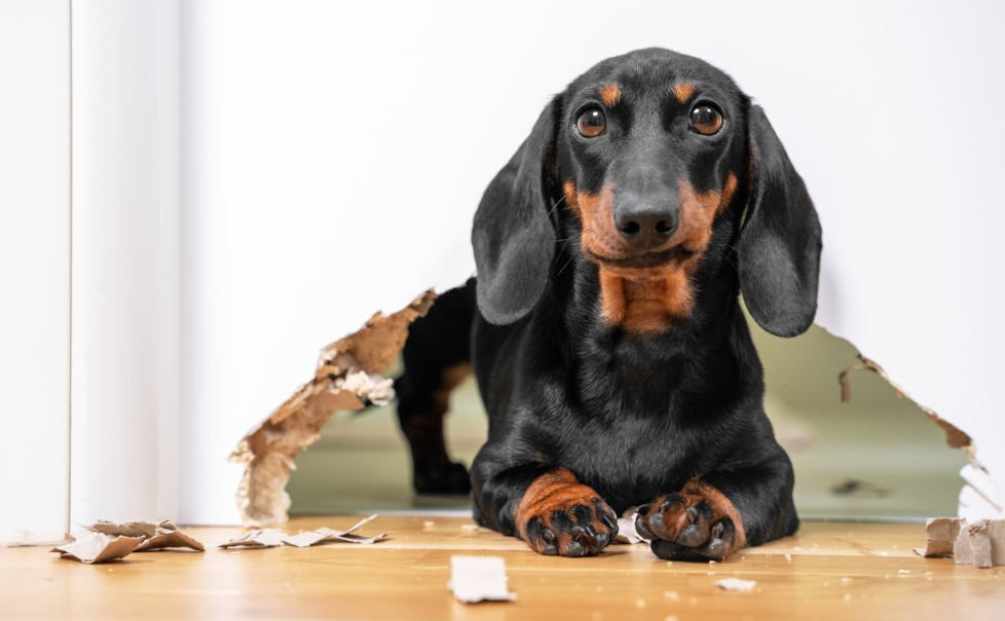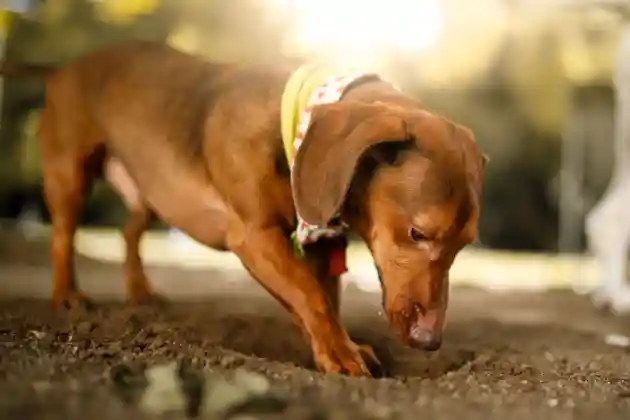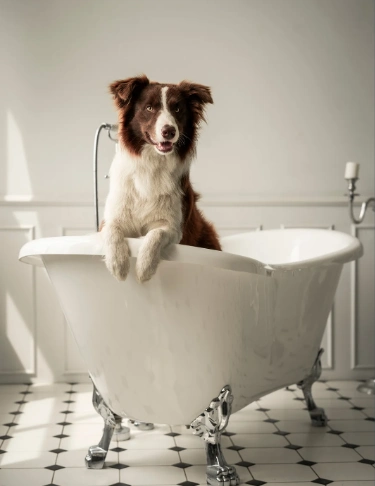Why Does My Dog Scratch the Wall? Understanding the Behavior and Finding 7 Solutions
Dog owners often find themselves puzzled when they witness their puppies vigorously scratching the walls. It’s a behavior that can leave behind unsightly marks and cause frustration.
If you’ve ever wondered why your dog engages in this peculiar habit, you’re not alone. In this article, we’ll delve into the reasons behind this behavior and explore possible solutions to help you and your dog coexist harmoniously.

Table of Contents
- Understanding the Natural Behavior of Dogs
- Understanding the Reasons Behind Of Dog Wall Scratching
- Solutions to Discourage Wall Scratching
- Addressing Potential Medical Issues
- Behavioral Training and Redirection
- Creating an Enriched Environment for Dog
- Managing Dog Stress and Anxiety
- Consistency and Patience in Training
- Tips For Dog Preventing Wall Scratching
- Conclusion
- FAQs
Understanding the Natural Behavior of Dogs
It’s essential to grasp their natural instincts to comprehend why dogs scratch walls. Scratching is an innate behavior that serves various purposes for dogs. It helps them mark their territory, shed the outer layers of their claws, stretch their muscles, and relieve stress. We can find suitable alternatives to redirect their behavior by understanding these instincts.
Understanding the Reasons Behind Of Dog Wall Scratching
- Boredom and Excess Energy:
Dogs are naturally curious and active creatures. When they lack stimulation or feel bored, they may scratch the walls to entertain themselves and burn off excess energy. Providing your dog with sufficient mental and physical stimulation through interactive toys, play sessions, and environmental enrichment can help alleviate this behavior.
- Territorial Marking:
Scratching is an instinctual behavior for dogs. By scratching, they leave visible and scent marks, establishing their territory. The walls may be particularly appealing to your dog if they are made of materials that allow for effective scratching and marking.
Appropriate alternatives, such as scratching posts or boards, can redirect this behavior to more suitable surfaces.
- Maintaining Claw Health:
Dogs’ claws constantly grow, and they must keep them in optimal condition. Scratching helps remove the outer dead layers of their claws, allowing new growth to come through. While scratching posts can fulfill this purpose, some dogs may prefer walls due to their texture.
Regular nail trimming can also aid in maintaining your dog’s claw health and minimize the need for excessive wall scratching.
Solutions to Discourage Wall Scratching

- Provide Ample Scratching Alternatives:
Invest in high-quality scratching posts or boards that match your dog’s preferences. Experiment with different materials, such as sisal, carpet, or cardboard, to determine which your dog finds most appealing. Place the scratching posts in areas where your dog spends the most time, ensuring easy accessibility.
- Use Deterrents on Walls:
Applying double-sided tape, aluminum foil, or a dog-safe deterrent spray to the walls can discourage your dog from scratching them. Dogs dislike the sticky or unpleasant textures these deterrents create. Be sure to test these methods in inconspicuous areas to avoid damaging your walls.
- Trim Your Dog’s Nails:
Regular nail trims help maintain your dog’s claws at an appropriate length, reducing the urge for excessive scratching. Familiarize yourself with the proper technique for nail trimming, or consult a veterinarian or professional groomer for guidance.
- Engage in Interactive Play:
Dedicate daily play sessions to engage your dog in interactive activities that provide mental and physical stimulation. Utilize toys that mimic prey-like movements or incorporate puzzle toys to challenge your dog’s problem-solving skills. A tired dog is less likely to resort to wall scratching out of boredom.
- Create an Enriching Environment:
Ensure your dog’s environment is enriched with opportunities for exploration and entertainment. Provide vertical spaces, such as dog trees or shelves, where your dog can climb, perch, and observe their surroundings. Rotate and introduce new toys periodically to keep your dog engaged and mentally stimulated.
puppiesdiary
Addressing Potential Medical Issues
While scratching is often expected, excessive or compulsive scratching could be a sign of an underlying medical issue. If your dog’s wall scratching seems unusual or intensified, it’s advisable to consult a veterinarian.
They can assess your dog’s health and rule out conditions like allergies, parasites, or skin infections that might contribute to the behavior.
Behavioral Training and Redirection
Training your dog to use appropriate scratching surfaces requires patience and consistency. Follow these steps:
- Positive Reinforcement: Encourage your dog to use the scratching posts by rewarding them with treats, praise, or playtime when they do so.
- Deterrents: Use harmless deterrents like double-sided tape, aluminum foil, or citrus-scented sprays on the walls to discourage scratching.
- Redirecting: When you dogch your dog scratching the walls, gently guide them towards a scratching post and encourage them to use it instead.
Creating an Enriched Environment for Dog
Enriching your dog’s environment can minimize the urge to scratch walls. Consider the following tips:
- Playtime: Engage your dog in interactive play sessions using toys that simulate hunting behaviors, providing an outlet
- Vertical Space: Dogs love climbing and observing their surroundings from high perches. Install dog trees or shelves to provide vertical space and entertainment.
- Scratching Surfaces Variety: Offer a variety of scratching surfaces like posts, mats, and cardboard scratchers to doger to your dog’s preferences.
- Hideouts and Perches: Create cozy hiding spots and comfortable perches where your dog can retreat and feel secure.
Managing Dog Stress and Anxiety

Stress and anxiety can contribute to wall-scratching behavior in dogs. Consider the following strategies to manage their emotional well-being:
- Routine and Stability: Dogs thrive on routine, so maintain consistent feeding, play, and sleeping schedules.
- Safe Zones: Designate safe zones where your dog can relax without being disturbed, providing a sense of security.
- Calming Environment: Use calming pheromone diffusers or sprays, soothing music, or visual stimuli like fish tanks to create a peaceful atmosphere.
Consistency and Patience in Training
Training your dog to abandon wall scratching requires consistency and patience. Remember these key points:
- Avoid Punishment: Never scold or punish your dog for scratching the walls. It can create fear or anxiety, making the behavior worse.
- Positive Reinforcement: Reward your dog whenever they use appropriate scratching surfaces, reinforcing the desired behavior.
- Redirect and Encourage: Whenever you dogch your dog scratching the walls, gently redirect them to the designated scratching posts and encourage them to use them.
Tips For Dog Preventing Wall Scratching
To prevent wall scratching altogether, consider the following preventive measures:
- Trimmed Claws: Regularly trim your dog’s claws or use soft nail caps to minimize the damage caused by scratching.
- Protective Coverings: Place protective coverings like plastic sheets or clear tape on the walls temporarily while you work on redirecting their behavior.
- Anti-Scratch Products: Explore commercial anti-scratch sprays or tapes designed to deter dogs from scratching specific surfaces.
- Supervision: Keep a close eye on your dog’s behavior and intervene when they show signs of scratching the walls, redirecting them to appropriate alternatives.
Conclusion
Understanding why your dog scratches the wall is essential for addressing this behavior effectively.
By providing appropriate scratching alternatives, addressing potential medical issues, implementing behavioral training, creating an enriched environment, managing stress, and practicing consistency, you can redirect your dog’s scratching habits to more suitable surfaces.
Patience, positive reinforcement, and understanding your dog’s needs are essential to successfully modifying their behavior.
Related Articles: –
Why do dogs always climb trees?
https://www.puppiesdiary.com/why-is-my-dog-howling-all-night/
FAQs
Is wall scratching a sign of a health problem?
While scratching is natural, excessive or intensified scratching may indicate an underlying health issue. Consult a veterinarian for proper evaluation.
My dog only scratches one particular wall. Why?
Dogs may have preferences for certain textures or lodging. Try providing scratching surfaces similar to the wall they prefer to redirect their behavior.
How long does redirecting my dog’s scratching behavior take?
The timeline can vary depending on your dog’s age, personality, and previous habits. Be patient and consistent in your training efforts.
Should I declaw my dog to prevent wall scratching?
Declawing is an invasive procedure and should be avoided. There are humane alternatives available to redirect your dog’s scratching behavior.






